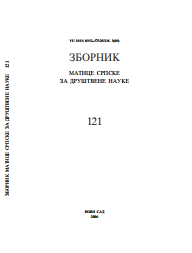СТАРОСНА СТРУКТУРА СТАНОВНИШТВА ВОЈВОДИНЕ ПРЕМА ТЕРИТОРИЈАЛНОЈ И НАЦИОНАЛНОЈ ПРИПАДНОСТИ
AGE STRUCTURE OF THE POPULATION OF VOJVODINA ACCORDING TO TERRITORY AND NATION
Author(s): Zoran MilovanovićSubject(s): Geography, Regional studies, Demography and human biology, Migration Studies
Published by: Матица српска
Keywords: age structure; age stages; age indicators; natural increase; migration;
Summary/Abstract: In the inter-census period, the process of ageing of the population of Vojvodina continued, and Vojvodina is in the stage of a deep demographic old age. The average age increased from 37,7 to 39,8 years, and the index of ageing from 71,0 to 94,1. Territorially speaking, the population of Vojvodina has a homogeneous age structure. All counties are in the stage of a deep demographic old age. Somewhat more favourable age structure is present in the South-Bački, Sremski and SouthBanatski counties. Homogeneity is also present at the municipal level. Out of 45 municipalities, 39 belong to the phase of a deep demographic old age, 5 to a demographic old age, and 1 to the deepest demographic old age, while in the 1991 census 38 municipalities belonged to the phase of a demographic old age, and 7 to the phase of a deep demographic old age. The oldest population is the one in the border municipalities and in the less developed municipalities (Plandište, Nova Crnja, Sečanj, Žitište, Irig, Alibunar), and the youngest in the municipalities Beočin, Vrbas, Žabalj, Temerin and Stara Pazova. Counties and municipalities with the unfavourable age structure had the unfavourable rates of natural increase in the inter-census period, and this tendency was also continued in the post-census period. Age structure of the population according to nationalities (for more than 1% in the total population) shows that the Croats, Hungarians and Romanians are the oldest (the deepest demographic old age), then the Slovaks and the Serbs (deep demographic old age). The Montenegrins and the Roma are the youngest ones. On the one hand, changes in the age structure are the result of the continual tendency for population ageing in the long term, but onn the other occurrences in the inter-census period which additionally accelerated this process.
Journal: Зборник Матице српске за друштвене науке
- Issue Year: 2006
- Issue No: 121
- Page Range: 305-312
- Page Count: 8
- Language: Serbian

